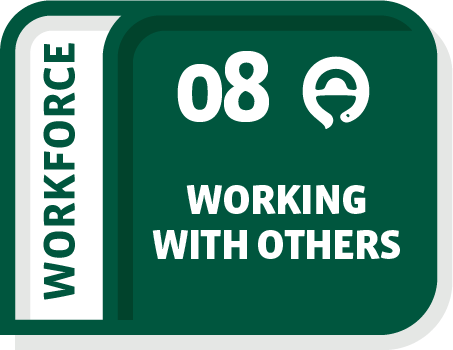Welcome to the Workforce Reference Guide for FIP Development Goal 8 Working with others. This guide collates all information, evidence and expertise from FIP to support our members with measuring progress, evaluation, implementation and transformation processes. To access the full Workforce Reference Guide for the FIP Development Goals, click here.

FIP Development Goal 8 Workforce Element
Globally, we will have:
Clearly identifiable elements of collaborative working and interprofessional education and training which should be a feature of all workforce development programmes and policies.
Mechanisms
- Evidence of policy formation to demonstrate how healthcare professionals can develop and engage in partnerships to achieve better health outcomes.
- Develop education and training strategies and programmes to ensure collaboration within the pharmaceutical workforce and training on medicines for other healthcare professionals.
- Ideally, this should be linked with formal professional development activities.
View all elements of FIP Development Goal 8 here.
Frameworks and tools
The Global Assessment Tool for Interprofessional Education is currently in process to support pharmacy educators & trainers develop collaborative health programmes.
FIP Reports
Interprofessional Education in a Pharmacy Context: Global Report (2015)
Key findings of the FIP Interprofessional Education in a Pharmacy: Global Report
FIP Publications
FIP Statement of Policy: Collaborative Pharmacy Practice, 2010; https://www.fip.org/file/1492
FIP Report on Transforming Pharmacy and Pharmaceutical Sciences Education in the Context of Workforce Development; 2017; https://www.fip.org/file/1387
Global Vision for Education and Workforce; Nanjing declaration 2016; https://www.fip.org/file/194
2013 FIPEd Global Education Report; https://www.fip.org/file/1410
Events & training
The immediate global impact of COVID-19 on higher education institutions & workforce development. Moderator: Jill Boone, Pierre Moreau. Panellists: Ian Bates, Louise Brown, Shepard Mhalaba, Mariet Eksteen and Vibhuti Arya and Jill Boone. https://www.fip.org/events?event=543
Innovations of IPE Implementation, Tina Brock, August 7, 2018: https://www.fip.org/events?event=374
Assessment of Interprofessional Education, Sylvia Langlois, July 10, 2018: https://www.fip.org/events?event=372
Interprofessional Education: defining the competencies and goals, Frank J. Ascone and Mariet Eksteen https://www.fip.org/events?event=367
Workforce Development Hub Global Leads for FIP Development Goal 8
|
Jill Boone (USA) Director of Interprofessional Education, Coordinator of Co-Curricular Program, Professor of Pharmacy Practice, James L Winkle College of Pharmacy, University of Cincinnati, OH, USA.
|
|
|
Astrid Czock (Switzerland) CEO of the interprofessionaL association QualiCCar, Experience as head of the department education, quality and science of pharmaSuisse, the Swiss pharmacy association (FIP MO).
|
|
|
Silvana Nair Leite (Brazil) Professor, Pharmaceutical Sciences, Federal University of Santa Catarina
|
Find out more about the FIP Workforce Development Hub and our other Global Leads here.
Collaborators
| Sarah Dineen-Griffin
PhD, Lecturer in Pharmacy Practice at the University of Technology Sydney |
Ongoing projects
- We are developing a global institutional tool for assessing interprofessional education.
Bibliography & further reading
-
Frenk J, Chen L, Bhutta ZA et al. Health professionals for a new century: transforming education to strengthen health systems in an interdependent world. 376(9756): 1923-1958, 2010.
-
Janssen M, Sagasser MH, Laro EAM et al., Learning interprofessional collaboration by participating in a consultation programme: what and how did primary and secondary care trainees learn? BMC Medical Education 17 (1): 125, 2017.
-
D`amour D, Oandasan I., Interprofessionality as the field of interprofessional practice and interprofessional education: an emerging concept. Journal of interprofessional care: 19(1): 8-20, 2005.
-
Olson R, Bialocerkowski A. Interprofessional education in allied health: a systematic review. Medical education, 48(3): 236-246, 2014.
-
Reeves S, Perrier L, Goldman J, Freeth D et al. Interprofessional education: effects on professional practice. Cochrane Database Syst Rev. 2013(3): CD002213.
-
Guraya SY, Barr H. The effectiveness of interprofessional education in healthcare: A systematic review and meta-analysis. Kaohsiung J Med Sci, 34(3): 160-165, 2018.
-
WHO. Framework for Action on Interprofessional Education & Collaborative Practice, 2010, http://www.who.int/hrh/nursing_midwifery/en/
-
Tracy Levett‐Jones et al., Case Studies of Interprofessional Education Initiatives From Five Countries, 2018, https://sigmapubs.onlinelibrary.wiley.com/doi/abs/10.1111/jnu.12384
-
Jill E. Thistlethwaite et al., Competencies and Frameworks in Interprofessional Education: A Comparative Analysis, Academic Medicine, Vol. 89, No. 6 / June 2014
-
Gloria R. Grice et al., Intentional Interprofessional Experiential Education, American Journal of Pharmaceutical Education 2018; 82 (3) Article 6502.
-
Parker K, Oandasan I., Interprofessional Collaborative Organization Map and Preparedness Assessment (IP-COMPASS); 2012.
-
Parker K, Jacobson A, McGuire M, Zorzi R, Oandasan I., How to build high-quality interprofessional collaboration and education in your hospital: the IP-COMPASS tool. Qual Manag Health Care. 2012 Jul-Sep;21(3):160-8.
-
IPC Competency Framework and Team Assessment Toolkit Supplementary References and Links Centre for Interprofessional Education, Toronto Academic Health Science Network Contact: Dean Lising, Centre for Interprofessional Education, dean.lising@uhn.ca
-
Interprofessional care performance assessment tool, Centre for Interprofessional Education, Toronto Academic Health Science Network Contact: Dean Lising, Centre for Interprofessional Education, dean.lising@uhn.ca and/or ipe.info@utoronto.ca
Find out more about the FIP Workforce Reference Guide and explore it fully here.